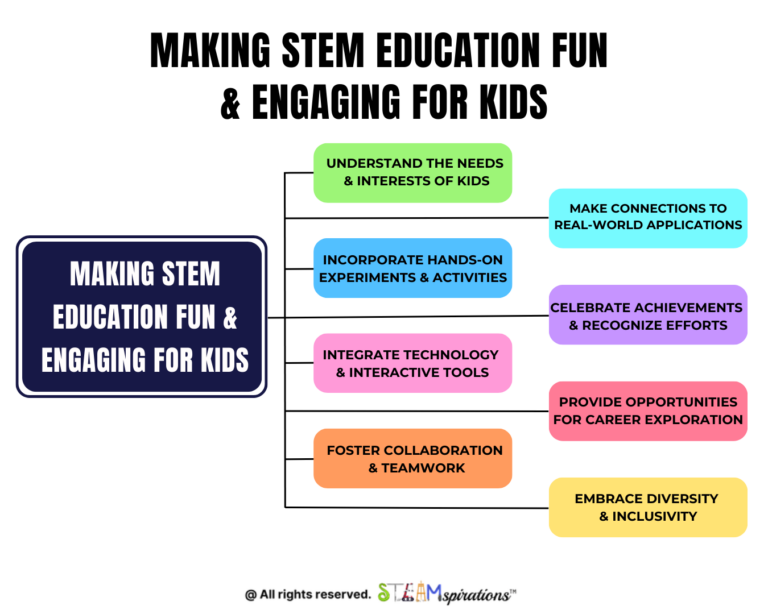Hey there, welcome to my article on the importance of STEM education in modern society! I’m thrilled to share my personal experience and insights with you as a professional STEM educator.
So, what is STEM education all about? Well, I can tell you that it’s a lot more than just memorizing formulas and solving equations. STEM education is all about exploring, experimenting, and discovering. It’s about using your creativity and critical thinking skills to solve real-world problems.
STEM education has had a significant impact on my life, both personally and professionally. As a kid, I loved exploring science and technology. I was always curious about how things worked, and I enjoyed tinkering with gadgets and machines.
Fast forward to my professional career, and I can confidently say that STEM education has opened many doors for me. I’ve had the opportunity to work on exciting projects and collaborate with some of the brightest minds in the field.
But the impact of STEM education goes beyond just personal success. STEM education is essential for the progress and development of modern society. It is the foundation for technological advancements in various fields, such as healthcare, transportation, and communication.
Moreover, STEM education plays a vital role in addressing global challenges, such as climate change and energy sustainability. By equipping our future generations with the necessary skills and knowledge, we can ensure a brighter and more prosperous future for all.
In this article, I will share with you the many benefits of STEM education and provide practical tips for students, teachers, parents, and anyone who wants to know about STEM. So, let’s embark on this exciting journey together and discover the fascinating world of STEM education!
Applications of STEM in Everyday Life
As we continue to explore the importance of STEM education, it’s important to consider the impact of STEM on modern society. STEM is not just a set of subjects taught in schools, it’s an integral part of our daily lives.
From the latest smartphone technology to medical advancements, STEM has transformed the way we live and work. We rely on STEM to make our lives more convenient and to solve complex global challenges.
Impact of STEM on the Economy
STEM education is not only essential for personal success but also for the progress and development of modern society. It plays a vital role in creating new jobs and driving economic growth.
As a professional STEM educator, I’ve seen firsthand the impact of STEM on the economy. STEM jobs are in high demand and offer better salaries and job security than other industries. By providing our future generations with STEM education, we can ensure they are equipped with the necessary skills and knowledge to succeed in the workforce of the future.
Thereby, societal growth. By promoting STEM education, we can create a brighter and more prosperous future for all. In the next section, we’ll dive deeper into the practical applications of STEM education in the real world.
STEM Education for Students
Now that we’ve discussed the importance of STEM education, let’s dive deeper into the opportunities available for STEM learning.
Importance of STEM in Career Development
Firstly, STEM education is crucial for career development. Many high-paying jobs, such as software engineering, data analysis, and medical research, require a strong foundation in STEM. By providing students with STEM education, we can open up more job opportunities and help them build a successful career.
Furthermore, STEM education can help students develop important skills such as problem-solving, critical thinking, and creativity. These skills are highly valued in the workforce and can be applied to a wide range of industries and professions.
As a STEM Educator, I’ve seen firsthand the benefits of STEM education. It’s not just about memorizing formulas and equations, but about applying them to real-world problems. I’ve had the pleasure of seeing my students use their STEM knowledge to create innovative solutions and tackle complex challenges.
Opportunities for STEM Learning
There are many opportunities available for STEM learning, both in and out of the classroom. Schools and community organizations often offer STEM programs and activities such as coding clubs, robotics teams, and science fairs. There are also many online resources available, such as YouTube tutorials and online courses, that allow students to learn at their own pace.
As a STEM educator, I encourage my students to take advantage of all the STEM learning opportunities available to them. By exposing themselves to a wide range of STEM topics and experiences, they can develop a deep understanding of STEM concepts and the skills necessary to succeed in the 21st-century workforce.
STEM Education for Teachers
In this section, we’ll explore the role of STEM education for teachers and how they can integrate STEM into their classroom curriculum.
Incorporating STEM in Classroom Curriculum
Incorporating STEM into classroom curriculum can be a great way to engage students and provide them with a deeper understanding of the material. One way to do this is by creating hands-on projects that allow students to apply STEM concepts to real-world problems. For example, a math class could design and build a bridge using geometry concepts, or a biology class could conduct experiments to study genetics.
As a STEM educator, I’ve found that incorporating STEM into my classroom curriculum has not only increased student engagement but also helped me develop as a teacher. By exploring new teaching strategies and resources, I’ve been able to create a more dynamic and engaging classroom environment.
Professional Development for Teachers
Professional development for teachers is also a valuable resource for STEM education. Many organizations offer workshops and training programs that focus on integrating STEM into the classroom. These programs not only provide teachers with new teaching strategies but also allow them to connect with other STEM educators and share ideas.
In my experience, attending professional development programs has not only improved my teaching skills but also provided me with new resources and ideas for STEM education. By connecting with other STEM educators, I’ve been able to learn from their experiences and incorporate new ideas into my own classroom.
STEM Education for Parents
In this section, we’ll discuss the role of STEM education for parents and how they can encourage STEM learning at home.
Encouraging STEM Learning at Home
Encouraging STEM learning at home can be as simple as incorporating it into everyday activities. For example, measuring ingredients and cooking together can help children develop math and science skills. Going on nature walks and observing the environment can help children develop an interest in biology and environmental science.
As a STEM educator, I’ve found that parents who are involved in their child’s education and show an interest in STEM can have a significant impact on their child’s success. By providing opportunities for STEM learning at home, parents can help their children develop a deeper understanding and appreciation for STEM subjects.
Providing STEM Resources for Children
Providing STEM resources for children can also be a valuable way to encourage STEM learning. There are many resources available, such as STEM kits, books, and educational videos, that can help children explore STEM concepts in a fun and engaging way. These resources can be especially helpful for parents who may not have a background in STEM themselves.
In my experience, parents who are supportive of their child’s STEM education and provide resources for them to learn can help their child develop a lifelong interest in STEM. By exposing children to STEM concepts and providing them with opportunities to explore and learn, parents can help prepare them for success in the 21st-century workforce.
Conclusion
Let’s recap the importance of STEM education in modern society. STEM education is essential for developing the critical thinking, problem-solving, and technical skills that are in high demand in the 21st-century workforce. It is not just a subject area, but a way of thinking and learning that prepares students for success in a rapidly changing world.
We’ve discussed how STEM education benefits students, teachers, parents, and society as a whole. By incorporating STEM education into curriculum and encouraging STEM learning at home, we can equip future generations with the skills they need to succeed in the workforce and tackle the challenges facing our world.
Call to Action for STEM Education
As a STEM educator, I urge everyone to take action and support STEM education in their communities. Whether it’s volunteering at a local STEM program, supporting STEM resources in schools, or advocating for STEM education policies, there are many ways to get involved and make a difference.
In conclusion, STEM education is vital for our society’s future success, and it’s up to all of us to support and invest in it. By working together, we can ensure that our children and future generations have the knowledge and skills they need to succeed and make a positive impact in the world. So let’s embrace STEM education and build a better future for ourselves and those who will come after us.

